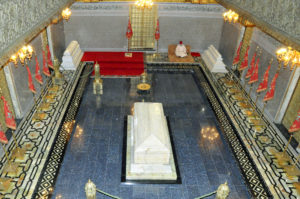
Interior of Mausoleum of Muhammad V in Rabat, Morocco (Photo by Don Knebel)
In 1927, the French, who gained control of Morocco in 1912, designated 18-year-old Sidi Mohammed ben Yusef as Morocco’s sultan or ruler. In 1940, the pro-Nazi regime of Vichy France ordered the sultan, a direct descendant of Muhammad, to impose severe restrictions on Morocco’s 250,000 Jews, who had lived in Morocco for centuries. Insisting that his title as Commander of the Faithful required that he treat all Moroccans equally, he refused. When Allied forces liberated Morocco in 1942, its Jewish community remained unharmed, with Jews still working in the sultan’s government. Sultan Muhammad, grateful for Morocco’s liberation, hosted the historic Allied conference in Casablanca in 1943.
When Morocco gained its independence in 1957, Sultan Muhammad became King Muhammad V. After he died suddenly in 1961, 75,000 Jews were among the public mourners. In 1962, King Muhammad’s son, King Hassan II, began construction of a mausoleum for his father near the river Bou Regreg. The mausoleum, completed in 1971, is a magnificent example of classic Moroccan architecture, with a gleaming white exterior and a green tile roof. Interior walls are covered with mosaics and the carved ceiling is covered in gold leaf. The mausoleum now includes the white onyx tombs of King Hassan II and his brother along with that of Muhammad V, located in the center. Visitors of all religions are allowed inside the mausoleum, which also serves as a mosque, where they can observe not only the tombs but a traditionally-dressed man sitting in the corner, reading from the Quran.
Rabat’s mausoleum is not only a monument to a king – it is monument to tolerance and respect. If you are in Rabat, it is a must see.